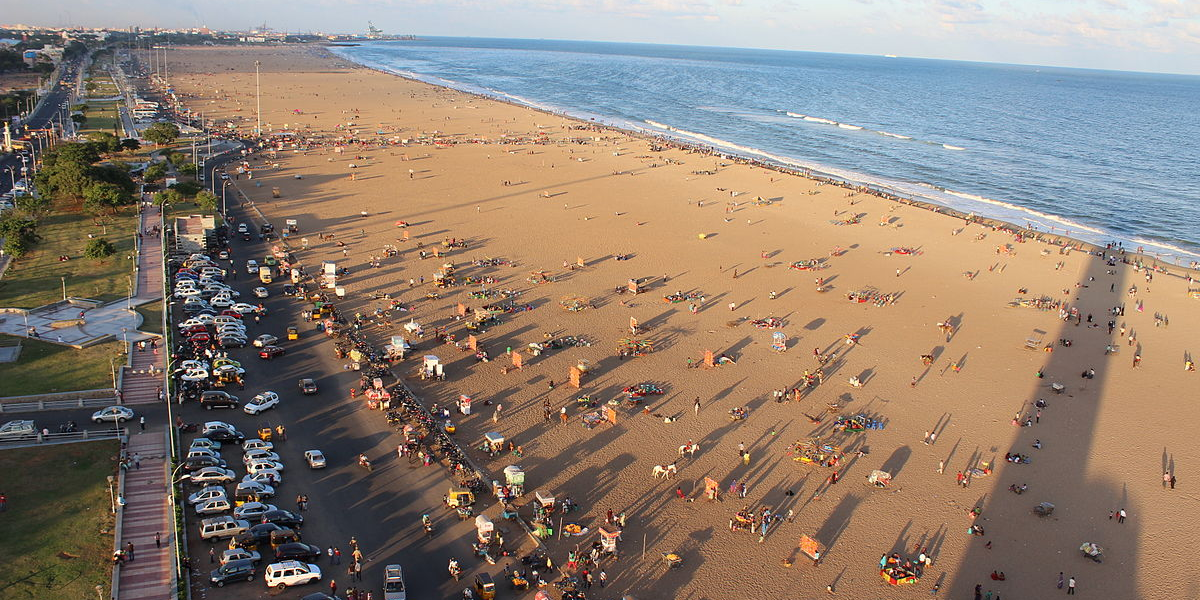The study, mapping sea level hotspots, looked at the effects of natural sea level fluctuations on the projected rise due to climate change.

The research team identified several Asian megacities that may face especially-significant risks by 2100 if society continues to emit high levels of greenhouse gases. (Chennai coast - Wikimedia Commons)
A sea level rise this century may disproportionately affect certain Asian megacities, as well as Western tropical Pacific islands and the western Indian Ocean, stated new research published in the journal Nature Climate Change.
The research team identified several Asian megacities — Chennai, Kolkata, Yangon, Bangkok, Ho Chi Minh City, and Manila — that may face especially-significant risks by 2100 if society continues to emit high levels of greenhouse gases.
The study looked at the effects of natural sea level fluctuations on the projected rise due to climate change, it said. It did so by mapping sea level hotspots around the globe.
Scientists have long known that sea levels will rise with increasing ocean temperatures, largely because water expands when it warms and melting ice sheets release more water into the oceans.
Studies have also indicated that sea level rise will vary regionally because shifts in ocean currents will likely direct more water to certain coastlines, including northeastern United States.
What is notable about this study is the way it incorporates naturally-occurring sea level fluctuations caused by such events as El Nino or changes in the water cycle, a process known as internal climate variability, the study said.
Sea level rise is going to affect some cities in Asia more than others & natural fluctuations like El Nino or the water cycle will play a major role.
🌊
With an NCAR coauthor, a new study observes sea level fluctuations w/ computer & statistical modelling: https://t.co/UWlhAmzexe pic.twitter.com/Jn4xElXu2x— NSF National Center for Atmospheric Research (@NCAR_Science) March 2, 2023
According to the study, by using both a computer model of global climate and a specialised statistical model, the scientists could determine the extent to which these natural fluctuations can amplify or reduce the impact of climate change on sea level rise along certain coastlines.
The study showed that internal climate variability could increase sea level rise in some locations by 20-30 percent more than what would result from climate change alone, exponentially increasing extreme flooding events, it said.
In Manila, for example, coastal flooding events are predicted to occur 18 times more often by 2100 than in 2006, based solely on climate change, the study said.
But, in a worst-case scenario, they could occur 96 times more often, based on a combination of climate change and internal climate variability, it said.
Internal climate variability will also increase sea level rise along the west coasts of the United States and Australia, it said.
The study drew on a set of simulations conducted with the National Center for Atmospheric Research (NCAR)-based Community Earth System Model that assumes society this century emits greenhouse gases at a high rate.
The simulations were run at the NCAR-Wyoming Supercomputing Center.
The paper stressed that the estimates of sea level rise come with considerable uncertainties because of the complex and unpredictable interactions in Earth’s climate system.
But the authors said that it is critical for society to be aware of the potential of extreme sea level rise in order to develop effective adaptation strategies.
“The internal climate variability can greatly reinforce or suppress the sea level rise caused by climate change,” said NCAR scientist Aixue Hu, who co-authored the paper.
“In a worst-case scenario, the combined effect of climate change and internal climate variability could result in local sea levels rising by more than 50 percent of what is due to climate change alone, thus posing significant risks of more severe flooding to coastal megacities and threatening millions of people,” said Hu.
(Disclaimer: The headline, subheads, and intro of this report along with the photos may have been reworked by South First. The rest of the content is from a syndicated feed, and has been edited for style.)

Jul 21, 2024

Jul 15, 2024

Jul 15, 2024

Jul 14, 2024

Jul 11, 2024

Jul 10, 2024